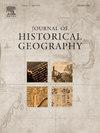Housing colonialism: Regulating low density communities in 1950s Hong Kong
IF 1.3
2区 历史学
Q2 GEOGRAPHY
引用次数: 0
Abstract
Hong Kong is famous for its high-density housing development. The European-centric planning during the pre-war period significantly shaped the spatial hierarchy. Notably, these low-density communities remain as exceptions to high-density built environment within the urban cores of Kowloon. New evidence indicates that the development dynamics of this low-density housing and the relevant regulations adopted by the colonial government in the 1950s significantly contributed to the contemporary modern regulations. This study examines the interplay between land leases and the Buildings Ordinance, to understand the development of property rights under colonial building regulations during the 1950s. During this period housing development and land speculation surged. Drawing on archival research of appeal cases within colonial memorandums, this study shows how ambiguities in the Buildings Ordinance and land lease shaped housing regulations. More importantly, this study reveals inconsistency within the colonial department agendas. It illustrates how the conflicting yet complementary functions of departmental agendas and building codes shaped the later practices of building regulation in Hong Kong. This tension not only contributes to an historical understanding of housing development densification, but also reveals how the rationales institutionalized through colonial departmental debates continue to influence today's housing landscape within the territory.
房屋殖民主义:1950年代香港低密度社区的规管
香港以高密度住宅开发而闻名。战前以欧洲为中心的规划极大地塑造了空间等级。值得注意的是,这些低密度社区仍然是九龙市中心高密度建筑环境的例外。新的证据表明,这种低密度住房的发展动态和殖民政府在20世纪50年代采用的相关法规对当代现代法规有重要贡献。本研究探讨土地契约与《建筑物条例》之间的相互作用,以了解在1950年代殖民地建筑规例下产权的发展。在此期间,房地产开发和土地投机活动激增。通过对殖民地备忘录中上诉案件的档案研究,本研究显示了《建筑物条例》和《土地契约》的模糊性是如何影响住房法规的。更重要的是,这项研究揭示了殖民部门议程的不一致性。它说明了部门议程和建筑守则相互冲突但又相辅相成的功能如何影响了香港后来的建筑规管做法。这种紧张关系不仅有助于对住房发展密度的历史理解,而且还揭示了通过殖民地部门辩论制度化的基本原理如何继续影响该地区今天的住房景观。
本文章由计算机程序翻译,如有差异,请以英文原文为准。
求助全文
约1分钟内获得全文
求助全文
来源期刊

Journal of Historical Geography
Multiple-
CiteScore
1.50
自引率
10.00%
发文量
53
期刊介绍:
A well-established international quarterly, the Journal of Historical Geography publishes articles on all aspects of historical geography and cognate fields, including environmental history. As well as publishing original research papers of interest to a wide international and interdisciplinary readership, the journal encourages lively discussion of methodological and conceptual issues and debates over new challenges facing researchers in the field. Each issue includes a substantial book review section.
 求助内容:
求助内容: 应助结果提醒方式:
应助结果提醒方式:


